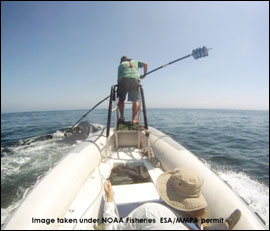|
Getting a Whale's-Eye View in Stellwagen Bank
 | | Click here for a larger image. Click here or on the picture to see a video of the tagging in action. |
This week, a team of government and university scientists is peering into the depths of Stellwagen Bank National Marine Sanctuary in an attempt to better understand whale behavior and the underwater world they inhabit. The primary tool they are using is National Geographic Crittercam – a video camera that is attached to the whales with suction cups. Once the camera pops off and is retrieved, the recorded video footage may show the types of fish the whales are feeding on and give clues to how the whales are catching their prey.
The Crittercam project evolved from earlier tagging studies using digital acoustic recording tags (DTags), that recorded whale depth, direction, pitch, roll and sounds created and received by whales. With data from the DTags, the sanctuary science team has begun to recognize particular humpback whale feeding patterns, including bottom feeding, single spiral bubble nets and double loops with lobtails. Although these previous studies provided data from which visualizations and animations showing movements could be developed, there was no actual video footage showing whale activity underwater in the sanctuary. With this project, the science team hopes to fill that gap.
In addition to the video camera tagging, additional studies will use a towed sonar system to study prey fields (the extent and density of fish, primarily sand lance). An extra project involves the collection of humpback whale dung (also referred to as “poop”). From these leavings, scientists can learn about the diet and health of the whale. But the primary use of the dung samples is to continue studies on nitrogen cycling in the ocean.
The project team and partners include:
Ari Friedlaender, Duke University, chief scientist
Michael Thompson, SBNMS lead scientist and GIS analyst
National Geographic Society
NOAA Fisheries Service
Whale Center of New England
University of Vermont
Harvard University
University of New Hampshire
International Fund for Animal Welfare
National Park Service
Woods Hole Oceanographic Institution |
|
Scientists from the University of Vermont and Harvard University have theorized that whales serve as an important agent in the delivery of nitrogen from the seafloor to the surface, where it becomes a kind of fertilizer for primary production. In the natural cycling of ocean nutrients, nitrogen gets caught up in algae, which is eaten by zooplankton. Eventually this material sinks to the seafloor. Small fish, such as sand lance, consume the plankton and, in turn, are eaten by the whales. The whales digest the food and excrete the dung into the photosynthetic surface waters, just as cows and elephants excrete dung onto grasslands.
The research cruises began July 6 and will continue until July 13 using the sanctuary's Research Vessel Auk as the on-the-water base of operations. An inflatable vessel, the Balaena, from Woods Hole Oceanographic Institution is being used to get researchers within tagging range of the whales.
Mission Blogs
July 7: Reflections on Reflection
Michael Thompson, Stellwagen Bank National Marine Sanctuary
Ari Friedlaender, Duke University
We tagged Reflection today. Today's on-the-water operation was almost a duplicate of yesterday's, with a couple of hours to locate whales and several tag attempts, and success at mid-day. From 12:30 p.m. - 4:30 p.m. the National Geographic Crittercam recorded Reflection's environment. But unlike yesterday, the sanctuary was a lot quieter. We saw lots of whales, but no sand lance and no active feeding. It'samazing the difference a day can make.
Reflection is an often-seen sanctuary whale that was first identified in September 1995 off Virginia Beach. Since 1997, she's been a regular summer resident in the Gulf of Maine and in sanctuary waters, bringing three calves to this feeding ground – Buzzard, Spiral and a 2009 calf that does not yet have a name. She received her own name based upon the symmetrical pattern on her flukes, with one side mirroring the other. When she feeds, she often uses a technique called “kick feeding,” which involves slapping the water with her tail. This day, though, we saw little of this surface behavior. We'll have to check the videos from the Crittercam to see what Reflection was actually seeing and doing.
July 6: Reuniting with Old Friends
Michael Thompson, Stellwagen Bank National Marine Sanctuary
Ari Friedlaender, Duke University
We caught up with an old friend on Stellwagen Bank today. His name is Tectonic – a humpback whale that had been studied using state-of-the-art acoustic recording tags during the 2008 and 2009 field seasons. The tags are used to provide fine scaled data on the underwater behavior of whales. Instead of an acoustic tag, this time we placed National Geographic's Crittercam on Tectonic's back while he was feeding on sand lance with another regular visitor named Echo.
The southern portion of Stellwagen Bank National Marine Sanctuary is a hot spot for humpback whales right now, as schools of small, pencil-thin sand lance – the whales' primary prey – fill the water. Our spotter plane, provided by the International Fund for Animal Welfare, did early morning reconnaissance and spotted the whales. After we arrived at the location, we began seeing more animals. We found ourselves amid a collection of about 30 whales, many of them demonstrating active feeding behaviors, including the sanctuary's matriarch Salt, grand dame of Stellwagen Bank humpback whales. This congregation was dead smack in the middle of the old shipping lane (which was moved in 2007 to an area with historically fewer whale sightings).
Using the sanctuary's inflatable boat, we were able to make a series of close approaches to several whales, with a successful camera placement – hooray! – accomplished at mid-day. We followed Tectonic and Echo for about four hours until the Crittercam floated free at 4:30 p.m.
|



